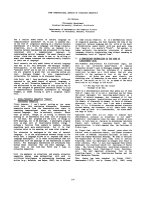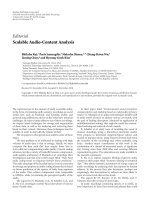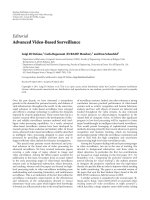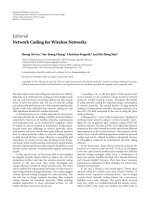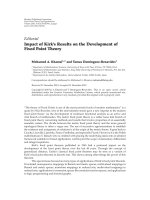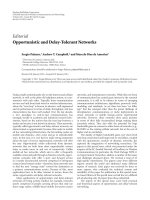Báo cáo hóa học: " Editorial Algorithmic Aspects of Wireless Networks" pptx
Bạn đang xem bản rút gọn của tài liệu. Xem và tải ngay bản đầy đủ của tài liệu tại đây (422.74 KB, 2 trang )
Hindawi Publishing Corporation
EURASIP Journal on Wireless Communications and Networking
Volume 2007, Article ID 52861, 2 pages
doi:10.1155/2007/52861
Editorial
Algorithmic Aspects of Wireless Networks
Xiuzhen Cheng,
1
Wei Li,
2
and Taieb Znati
3
1
Department of Computer Sc ience, The George Washington University, Washington, DC 20052, USA
2
Department of Electrical Engineering and Computer Science, The University of Toledo, Toledo, OH 43606, USA
3
Department of Computer Science, University of Pittsburgh, Pittsburgh, PA 15260, USA
Received 2 May 2007; Accepted 2 May 2007
Copyright © 2007 Xiuzhen Cheng et al. This is an open access article distributed under the Creative Commons Attribution
License, which permits unrestricted use, distribution, and reproduction in any medium, provided the original work is properly
cited.
Recent advances in electronic and computer technologies
have paved the way for the proliferation of ubiquitous wire-
less networks. Fast deployment of these communication net-
works for the users is preferred under many situations. Top-
ics that are related to a d hoc and sensor networking, mobile
computing, and wireless and mobile security have been ex-
tensively studied recently. Potential applications of these net-
works include search and rescue, smart homes, battlefield
surveillance, environment monitoring and control, and so
forth.
In response to the above demand for wireless networks,
this special issue aims at providing a timely and concise ref-
erence of the current activities and findings in the relevant
technical fields, as well focuses on the state-of-the-art and
up-to-date efforts in the algorithmic aspects of wireless net-
works include location management, topology control and
coverage, security and privacy, scalable design, cross-layer
design, resource optimization, QoS, to just name a few. We
believe that almost all papers included in this special issue
not only provide novel ideas, new analytical models, simula-
tion and experimental results, and handful experience in this
field, but also simulate the future research activities in the
area of the quality of service for mobile ad hoc networks. A
brief summary of each paper is listed as follows.
The first paper, by M. Shabany et al., proposes a novel
framework to model downlink resource allocation problem
in multiservice direct sequence code division multiple access
(DS-CDMA) cellular networks. This framework is based on
a defined utility function, which leads to utilizing the net-
work resources in a more efficientway.Thisutilityfunction
quantifies the degree of utilization of resources. As a mat-
ter of fact, using the defined utility function, users’ channel
fluctuations and their delay constraints along w ith the load
conditions of all BSs are all taken into consideration. Un-
like previous works, the authors solve the problem with the
general objective of maximizing the total network utility in-
stead of maximizing the achieved utility of each base-station
(BS). It is shown that this problem is equivalent to finding
the optimum BS assignment throughout the network, which
is mapped to a multidimensional multiple-choice Knapsack
problem (MMKP). Since MMKP is NP-hard, a polynomial-
time suboptimal algorithm is then proposed to develop an
efficient base-station assignment. Simulation results indicate
a significant performance improvement in terms of achieved
utility and packet-drop ratio.
The second paper, by M. Ding et al., introduces the au-
thors’ exploratory work toward identifying the targets in sen-
sor networks with faulty sensors. They explore both spatial
and temporal dimensions for data aggregation to decrease
the false alarm rate and improve the target position accuracy.
To filter out extreme measurements, the median of all read-
ings in a close neighborhood of a sensor is used to approx-
imate its local observation to the targets. The sensor whose
observation is a local maximal computes a position estimate
at each epoch. Results from multiple epochs are combined
together to further decrease the false alarm rate and im-
prove the target localization accuracy. Their algorithms have
low computation and communication overheads. Simulation
study demonstrates the validity and efficiency of their design.
The third paper, by T. Li et al., analyzes security weakness
of the operational and proposed CDMA systems and presents
an encryption-based secure scrambling process. First, instead
of using the long code sequences generated by the LFSR di-
rectly, the scrambling sequences are generated through AES
operations. As a result, the physical layer built-in security of
the CDMA system is significantly increased with very lim-
ited complexity load. Second, it is shown that by scram-
bling, the training sequence and the message sequence sepa-
rately with two independent scr a mbling sequences, both in-
formation privacy and system performance, can be further
2 EURASIP Journal on Wireless Communications and Networking
improved. Finally, error-tolerant decryption can be achieved
through secure scrambling. The proposed scheme is very fea-
sible and can be readily implemented for security enhance-
ment in wireless networks.
The fourth paper, by S. Guo et al., considers the prob-
lem of maximizing the network lifetime for both single and
multiple multicast connections in a wireless ad hoc net-
work (WANET) that use omnidirectional/directional anten-
nas and have limited energy resources. Unlike most central-
ized multicast algorithms, the authors provide a globally op-
timal solution to this problem in a distributed manner for the
special case of single multicast session in a WANET with om-
nidirectional antennas. This graph-theoretic approach pro-
vides us with insights into more general case of using direc-
tional antennas, and inspires us to produce a group of dis-
tributed algorithms. Experimental results show that our dis-
tributed algorithms outperform other centralized multicast
algorithms significantly in terms of network lifetime for both
single session and multiple session scenar ios.
The fifth paper, by J. Wang and M. Song, analyzes ex-
isting AQM schemes and proposes a rate-based exponen-
tial AQM (REAQM) scheme. The proposed REAQM scheme
uses input rate as the primary metric and queue length as the
secondary metric. The objectives are to stabilize the system
with low packet delay, low packet loss, and high link utiliza-
tion regardless the dynamic of network conditions. The au-
thors prove the global asymptotic stability of the equilibrium
based on Lyapunov theory. Simulation results indicate that
REAQM is capable of performing well for TCP flows over
both wired and wireless links, and has comparable imple-
mentation complexity as other AQM schemes.
The sixth paper, by Q. Liang, firstly performs some
theoretical studies on radar sensor network (RSN) design
based on linear frequency modulation (LFM) waveform: (1)
the conditions for waveform coexistence, (2) interferences
among waveforms in RSN, (3) waveform diversity in RSN.
Then the author applies RSN to ATR with delay-doppler
uncertainty and proposes maximum-likelihood (ML) ATR
algorithms for fluctuating target and nonfluctuating target.
Simulation results show that the author’s RSN vastly reduces
the ATR error comparing to a single radar system in ATR
with delay-doppler uncertainty. The proposed waveform de-
sign and diversity algorithms can also be applied to active
RFID sensor networks and underwater acoustic sensor net-
works.
The seventh paper, by Y. Kubo and K. Sekiyama, deals
with a novel communication t iming control for wireless net-
works and radio interference problem. Communication tim-
ing control is based on the mutual synchronization of cou-
pled phase oscillatory dynamics with a stochastic adaptation,
according to the history of collision frequency in commu-
nication nodes. Through local and fully distributed interac-
tions in the communication network, the coupled phase dy-
namics self-organizes collision-free communication. In wire-
less communication, the influence of the interference wave
causes unexpected collisions. Therefore, they propose a more
effective timing control by selecting the interaction nodes ac-
cording to received signal strength.
The last paper, by R. J. Haines et al., reviews and com-
pares different mechanisms, to achieve this end, and a num-
ber of different means of obtaining the configurations them-
selves. They describe an analytical model of the system un-
der consideration and present two mathematical approaches
to derive solutions for any system configuration and de-
ployment, along with an adaptive feedback-based solution.
They also describe a comprehensive simulation-based model
for the problem, and a prototype that allows comparison
of these approaches. Their investigations demonstrate that a
self-adaptive dynamic approach far out-performs any static
scheme, and that using a mathematical model to produce the
configurations themselves confers several advantages.
In closing, we would like to thank the support from the
Editor-in-Chief, Phillip Regalia, and the contributions from
authors and reviewers, to make this special issue possible.
Xiuzhen Cheng
Wei Li
Tai eb Z nat i
